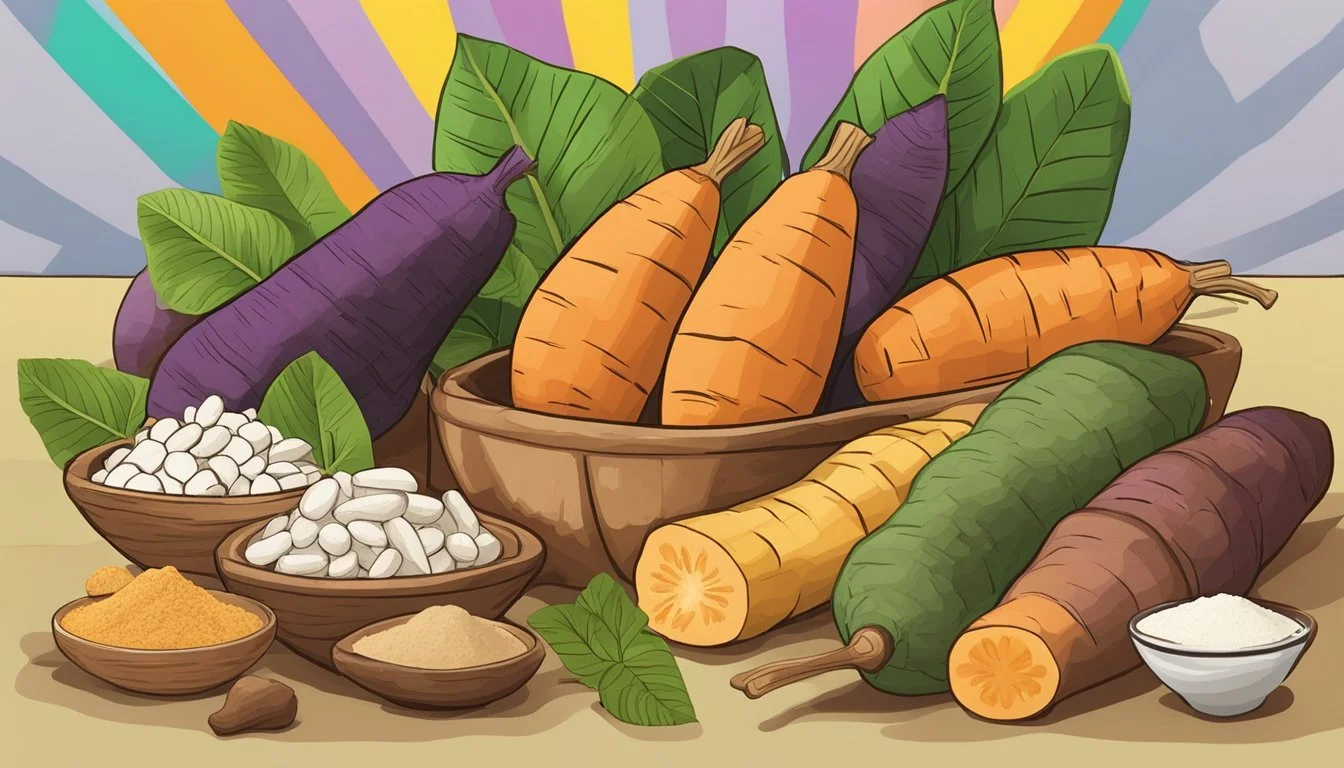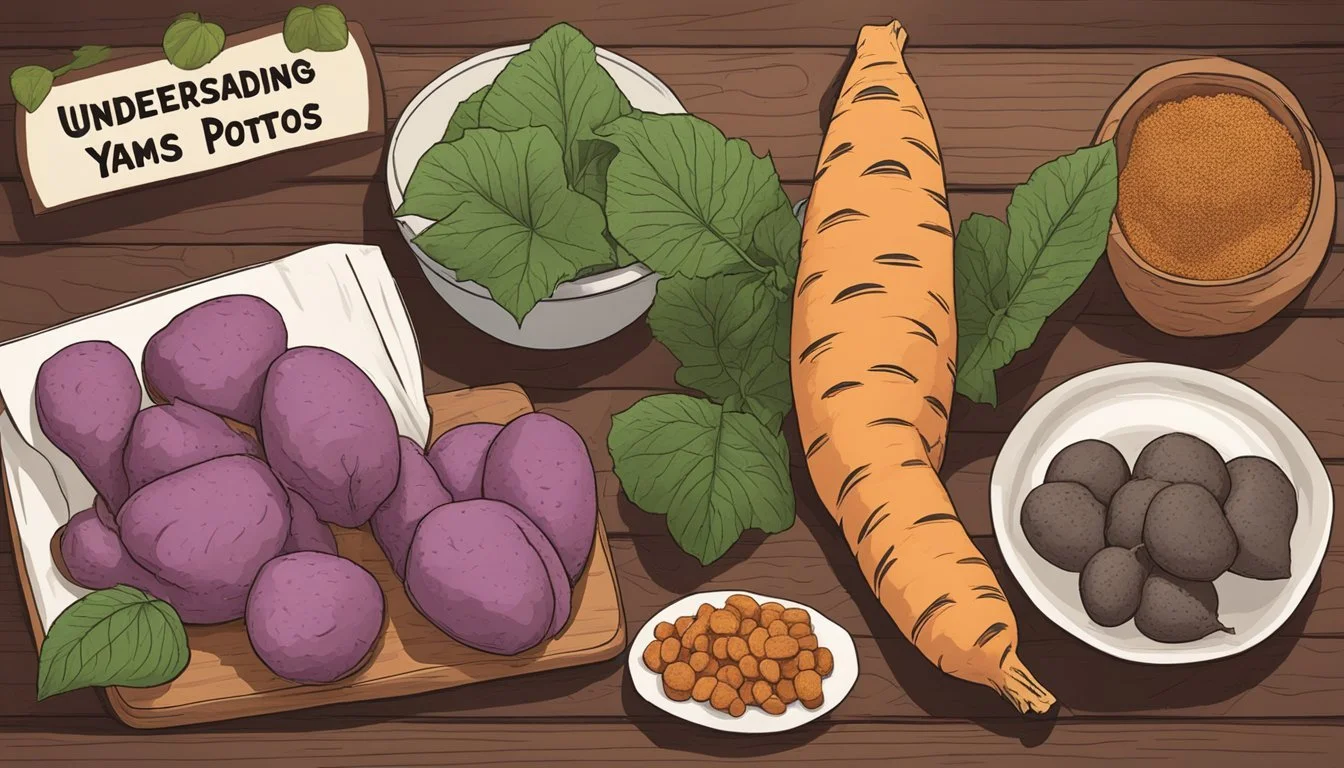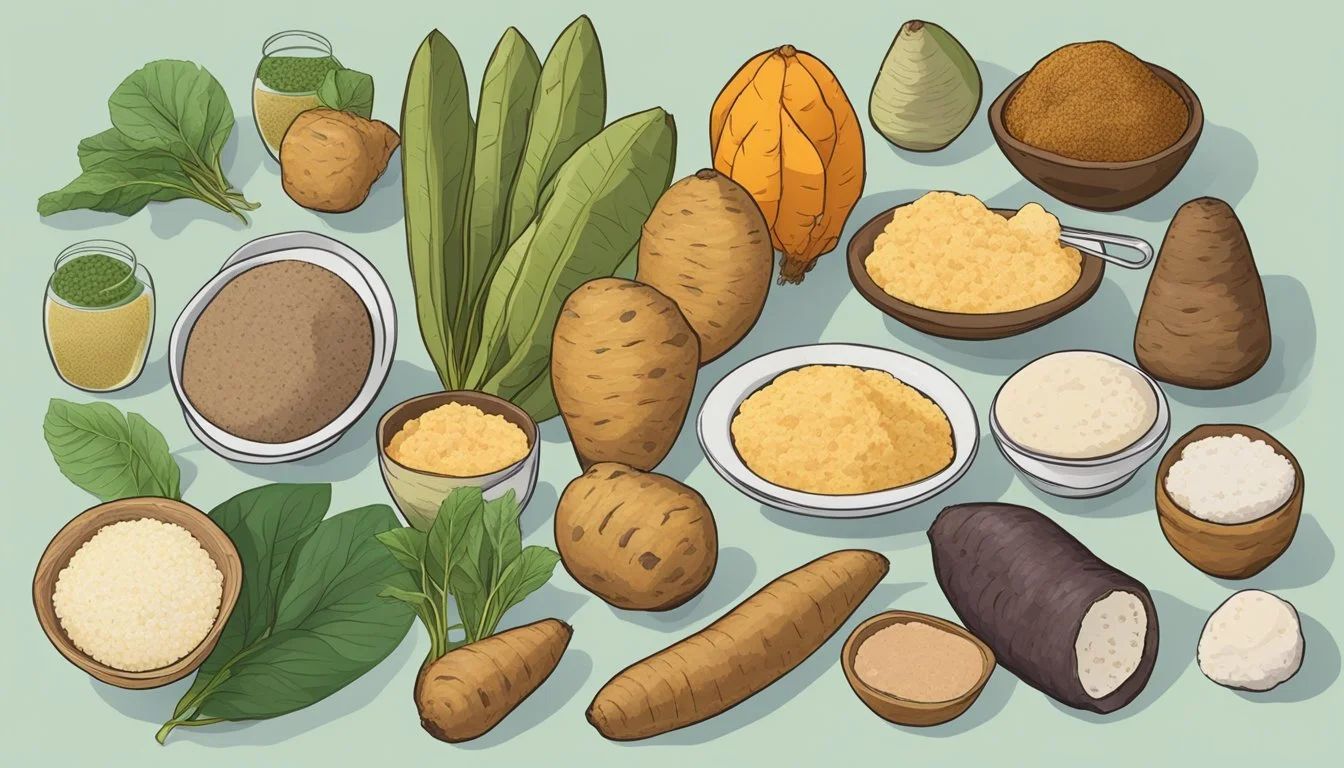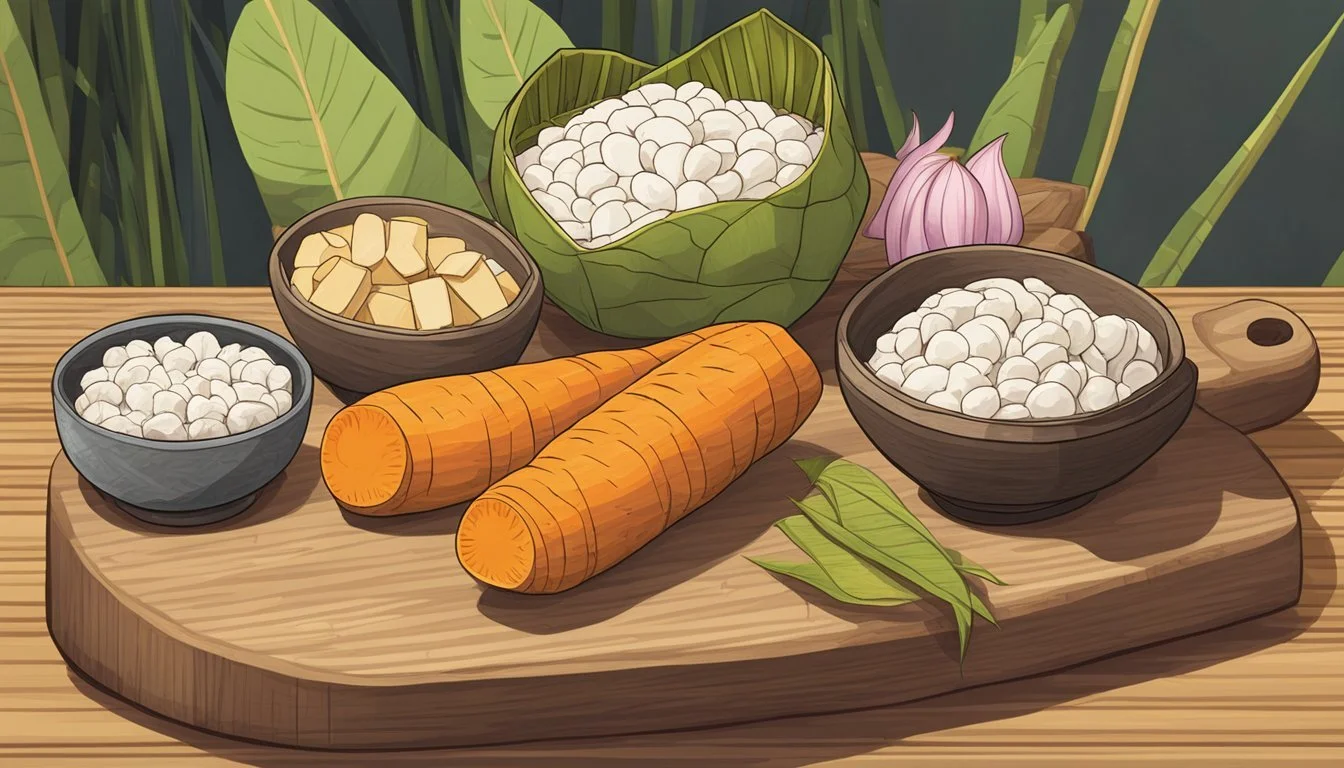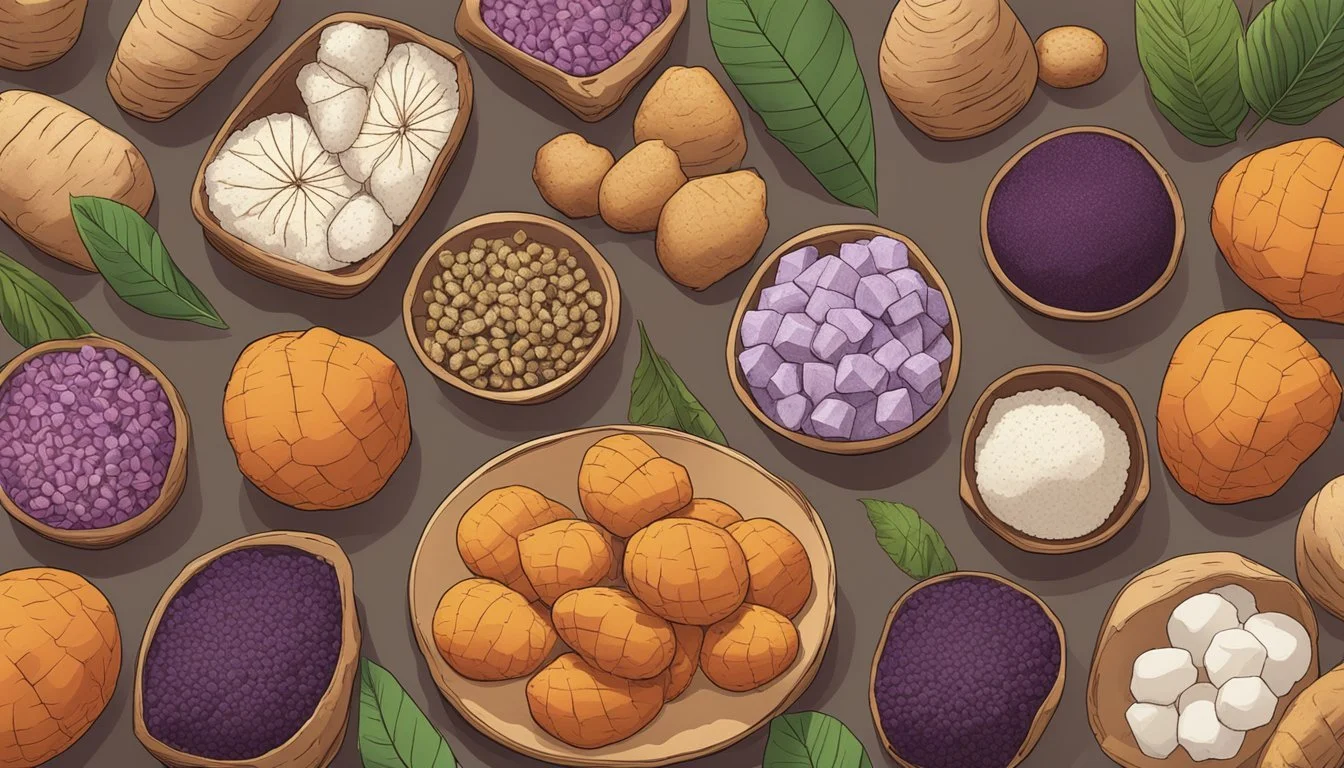Yam Substitutes
Top Alternatives for Your Cooking Needs
Yams, with their earthy sweetness and versatile texture, are a staple in many cuisines around the world. They're often used in a variety of dishes, from stews and casseroles to desserts. However, due to dietary preferences, availability, or the desire for a change in flavor or texture, individuals may seek alternatives to the traditional yam.
Among the substitutes, acorn squash stands out for its textural similarities and its ability to soak up flavors, making it a suitable replacement in recipes calling for yams. Equally nutritious, acorn squash is rich in vitamins, minerals, and dietary fiber. On the other hand, carrots and parsnips, with their inherent sweetness and ability to become tender when cooked, can mimic the taste profile of yams in many dishes.
For those looking to replicate the sweet, creamy qualities of yams, options such as Japanese sweet potatoes (What wine goes well with potatoes?) and Garnet potatoes provide close alternatives. These substitutes not only maintain the desired consistency but also contribute their unique nutritional benefits, making them excellent choices for those exploring different ingredients in their culinary endeavors.
Understanding Yams
Yams are tuberous roots that are often confused with sweet potatoes but have distinct characteristics and nutritional values crucial to many diets around the world.
Yam Basics
Yams are starchy tubers that belong to the genus Dioscorea. They are cultivated in temperate and tropical regions, notably in South America, Asia, the Caribbean, and West Africa. Texture-wise, yams have a rough skin and can range from firm to soft when cooked, depending on the variety. Sweet potatoes often get mistaken for yams, especially in the United States, but the two vegetables are botanically distinct. While sweet potatoes have a creamy texture and a sweet taste, yams tend to be more earthy in flavor and more traditionally used in savory dishes.
Nutritional Profile
Yams are a good source of dietary fiber and carbohydrates, making them a filling and energy-dense food option. They are high in certain vitamins and minerals, with notable amounts of:
Vitamin C: Supports immune function
Potassium: Important for blood pressure control
Manganese: Plays a role in metabolism and bone formation
Vitamin B6: Essential for brain health and energy metabolism
Magnesium: Involved in over 300 biochemical reactions in the human body
Here's a quick nutritional breakdown for yams:
Nutrient Amount per 100g Carbohydrates 28 g Dietary Fiber 4.1 g Vitamin A 2 IU Vitamin B6 0.293 mg Vitamin C 17.1 mg Potassium 816 mg Calcium 17 mg Iron 0.54 mg Magnesium 21 mg Antioxidants Present
Yams also contain antioxidants, which are compounds that help fight free radicals in the body, although the specific types and levels of antioxidants present can vary among different yam species.
Common Yam Substitutes
When searching for alternatives to yams, it's essential to consider substitutes that offer a comparable texture and flavor profile. The following options are widely recognized for their ability to mimic the qualities of yams in various culinary applications.
Sweet Potatoes
Sweet potatoes are often the first choice as a yam substitute due to their similar characteristics. They are especially prevalent in Asian, Caribbean, and West African cuisines where yams are a staple. Ratio: One can typically replace yams with sweet potatoes in a one-to-one ratio.
Butternut Squash
Butternut squash brings a slightly sweet and nutty flavor, making it another excellent alternative. In recipes where the dense texture of yams is desirable, butternut squash stands out as a viable option, providing comparable nutrition and a rich, creamy taste.
Pumpkin
Pumpkin is a versatile substitute that embodies a sweet taste with a hearty texture. It can well serve in place of yams in baked goods or soups, especially during the autumn season when it is readily available.
Plantains
Plantains share a starchy quality and adaptability in cooking methods similar to yams. While they have a distinct flavor, plantains can be a creative stand-in for yams in savory dishes, often found in the same tropical regions.
Potato Variants
Different potato variants, such as russets or Yukon Golds, can be apt substitutes for yams, particularly in recipes where the unique sweetness of yams is not the main highlight. These potatoes work well for a neutral-tasting replacement with a starchy, satisfying texture.
Each of these substitutes offers a distinct flavor and texture profile, some leaning closer to the sweet, earthy notes of yams while others provide a versatile backdrop suitable for a variety of seasonings and cooking styles.
Preparation Methods for Substitutes
When substituting yams in recipes, the cooking methods can greatly affect the texture and flavor of the dish. Selecting the appropriate substitute involves considering how it will be prepared.
Baking
Baking substitutes like sweet potatoes, can capture similar sweetness and tenderness. They require a one-to-one ratio and can be baked at the same temperature as yams, typically between 350°F to 400°F. Acorn squash, another substitute, should be halved and seeded with a light brushing of olive oil before baking to enhance its natural flavors.
Boiling
Boiled substitutes need attentive timing to prevent over-softening. Sweet potatoes can be peeled, cubed, and boiled for approximately 10 to 15 minutes until fork-tender. Starchy alternatives, such as white potatoes, can also be used, seasoned with a pinch of salt to maintain a balanced flavor profile.
Roasting
Roasting enhances the natural sugars in substitutes like acorn squash and carrots. Tossed with olive oil, salt, and pepper, these substitutes should be roasted at high heat (around 425°F) until they caramelized on the exterior — usually 25 to 30 minutes. Stirring midterm ensures even cooking.
Steaming
Steaming is ideal for substitutes that benefit from moisture retention. For instance, sweet potatoes or chunks of taro can be steamed over boiling water until they can be easily pierced with a fork, typically 20-30 minutes. This method keeps the ingredients firm enough to hold structure in recipes.
Frying
Frying requires high temperature and an understanding of the substitute's cooking time. Sweet potatoes cut into fries should be fried in oil at 375°F until golden brown. If using a softer substitute like plantains, the cook should monitor closely, as they require less time in hot oil to achieve the desired crispy texture.
Specific Dietary Considerations
When choosing yam substitutes, it is crucial to consider how they align with specific dietary goals, from calorie content to protein levels and gluten presence.
Low-Calorie Options
For individuals monitoring their calorie intake, substituting yams with acorn squash is beneficial. Acorn squash is not only lower in calories but also retains a similar texture and flavor. It's a high-fiber alternative that supports a low-calorie diet effectively.
Substitute Calorie Comparison (per 100g) Yam 118 kcal Acorn Squash 40 kcal
High-Protein Substitutes
Those seeking high-protein substitutes might opt for tofu, especially in dishes like okonomiyaki. Tofu is versatile and provides a protein boost without compromising the dish’s integrity.
Substitute Protein Content (per 100g) Yam 1.5g Tofu 8g
Gluten-Free Alternatives
For a gluten-free diet, selecting substitutes such as sweet potatoes ensures that the desired texture is achieved without the inclusion of gluten. Sweet potatoes are also rich in dietary fiber, aiding in digestion and overall health.
Substitute Gluten Content Fiber Content (per 100g) Yam Gluten-Free 4.1g Sweet Potatoes Gluten-Free 3g
Asian-Inspired Substitutes
In developing Asian-inspired dishes that traditionally use yams, chefs often turn to regional vegetables that impart similar textures and flavors. Key ingredients like nagaimo, taro, satsumaimo, and lotus root are staples in Asian cuisine and can be used creatively to emulate the qualities of yams.
Nagaimo
Nagaimo, a long tuber also known as the Chinese yam, is favored for its unique sticky texture when grated. It is commonly used in Japanese cooking to add body to dishes like okonomiyaki, where it provides a fluffy consistency upon heating. To prepare, Nagaimo can be peeled and sliced, then sautéed with a touch of soy sauce for a simple yet satisfying dish.
Taro
Taro is a starchy root that when cooked becomes soft and slightly sweet, making it an excellent substitute for yams. In Asian cuisine, taro is versatile, used in both savory stews and sweet desserts. Chefs should note that it's best to cook taro thoroughly, as it can be irritating when raw.
Satsumaimo
The Japanese Sweet Potato, or Satsumaimo, has a natural sweetness with a creamy texture. Less sweet than its American counterpart, it can be used in similar applications where a subtle sugar content is desired. Adjusting the dish with a bit of sugar or mirin can achieve the perfect balance of sweetness.
Lotus Root
Lastly, Lotus Root, known for its distinctive holes and crunchy texture, brings an aesthetic appeal to dishes. It absorbs flavors like dashi base well, making it a suitable addition to soups and stir-fries that typically feature yams. Sliced and cooked until tender, lotus root provides a satisfying crunch and visual interest to Asian-inspired recipes.
Culinary Uses for Yam Substitutes
When a recipe calls for yams and they are unavailable or someone seeks a different taste or nutritional profile, numerous alternatives offer similar consistency and flavor. The right substitute can maintain the dish's integrity while providing a unique twist.
In Soups and Casseroles
For soups and casseroles where yams contribute a creamy texture and slightly sweet flavor, acorn squash is an excellent replacement. It closely mirrors the texture of yams and adds a hint of nutty flavor. To integrate acorn squash into these dishes, one should first roast, bake, or steam the squash until tender, then incorporate it into the recipe as they would yams.
Sweet potatoes are another prominent substitute, offering a near-identical sweetness and creaminess. They can directly replace yams in a one-to-one ratio and work exceptionally well in both soups and casseroles, creating a hearty and comforting dish.
For Baked Goods and Puddings
In the realm of baked goods and puddings, the sweetness and moisture content of yams play a pivotal role. Here, using sweet potatoes can yield a smooth and moist texture, with the bonus of a familiar flavor that complements spices such as cinnamon and nutmeg.
One can also explore butternut squash for its sweet profile and soft consistency, enhancing pies, cakes, and other desserts. Ensure that the squash is pureed to a smooth consistency for an even distribution throughout the batter or pudding mixture.
Alternative Thickeners for Recipes
For those recipes where yams serve as a thickening agent, cook should consider potato starch or taro. They offer a gluten-free way to achieve the desired thickness and creaminess in a variety of dishes, from gravies to stews. Here's how they can be used:
Potato starch: Use in a 1:1 ratio to thicken sauces, soups, and gravies, ensuring no lumps form.
Taro: When cooked and pureed, it provides a creamy texture ideal for tropical-inspired recipes.
Each substitute, whether for its creaminess, thickening properties, or sweet, earthy taste, brings something unique to the table without straying from the original purpose of the yam in the recipe.
Exploring Texture and Flavor
When considering substitutes for yams, one must closely match the original's texture and flavor profile. Within these parameters, suitable alternatives fall into distinct categories, ranging from creamy and smooth to crunchy and firm, with variations in taste from sweet to nutty.
Creamy and Smooth Substitutes
For a substitute that mirrors the creamy texture and flavor of yams, acorn squash is an excellent choice. Once cooked, its flesh becomes soft and smooth, offering a similar mouthfeel. Moreover, it provides an array of nutrients, including a creamy flavor that doesn't overpower other ingredients. Other vegetables like butternut squash or pumpkin can also serve well in this category, especially in pureed forms for soups or incorporated into baked goods for a subtle sweetness and smooth consistency.
Crunchy and Firm Textures
If a recipe calls for yams but one desires a crunchier texture, carrots or parsnips may be a preferable option. These root vegetables maintain a firm structure even when cooked, adding a bite that stands out in a dish. They should be diced or sliced and can be roasted to enhance their inherent crunchiness.
Sweet and Nutty Flavors
Sweet potatoes are the closest alternative to yams, offering a sweet and sometimes nutty flavor quite similar to yams. They can replace yams at a one-to-one ratio without significantly altering the taste profile of a dish. Sweet potatoes' naturally sweet taste and dense texture make them a versatile ingredient in both savory and sweet dishes.
Substitute Storage and Handling
When considering substitutes for yams, one should be aware of the proper storage techniques and preparation methods. This ensures that the alternatives retain their flavor and texture, mirroring that of the original ingredient as closely as possible.
Storage Techniques
For acorn squash:
Room Temperature: Store in a cool, dry place away from direct sunlight for up to 1 month.
Refrigerated: In a crisper drawer, they stay fresh for up to 3 months.
For sweet potatoes:
Room Temperature: Best kept in a cool, dark, and well-ventilated area for up to 2 weeks.
Do Not Refrigerate: Refrigeration alters texture and taste.
General Tips:
Avoid washing substitutes before storing as moisture can hasten decay.
Keep away from ethylene-producing fruits like apples, which can lead to premature spoilage.
Preparation and Cooking Tips
Before cooking:
Wash substitutes thoroughly to remove any dirt.
Cut into uniform size to promote even cooking.
For acorn squash and similar vegetables:
Can be baked, roasted, or steamed.
To enhance sweetness, a light brushing of oil and a sprinkle of salt before roasting is advisable.
For sweet potatoes:
Boiling: Start in cold water and bring to a boil for even cooking.
Microwaving: Pierce the skin several times and cook for 5-8 minutes, turning halfway through.
Cooking Ratios: Substitute in a 1:1 ratio for most recipes. Adjust the quantity based on personal preference and recipe needs.
Social Media and Yam Substitutes
Instagram and Facebook have become integral platforms for sharing culinary experiences and knowledge. Users on these social media sites frequently exchange information about various substitutes for cooking ingredients, including yams. Yam substitutes are especially popular among those looking for alternatives due to dietary restrictions, availability issues, or simply to experiment with different flavors and textures in traditional recipes.
For instance, a common substitute highlighted by online cooking enthusiasts is the sweet potato. It is often recommended to use an equal ratio when replacing yams with sweet potatoes due to their similar texture and sweet flavor. This makes switching easy for recipes calling for yams.
Yam Substitute Recommended Cooking Method Social Media Platform Sweet Potato Roasting, Baking, Steaming Instagram, Facebook Acorn Squash Baking, Sautéing Instagram Carrots Boiling, Roasting Facebook
Recipe modifications using these substitutes are widely shared, with users posting photos and videos detailing the preparation process. Tutorial-style posts demonstrate how to properly use substitutes like acorn squash, which can be baked or sautéed, ensuring that the end result maintains a similar consistency to that of yams.
Chefs and home cooks regularly leverage these platforms to showcase their culinary creations. They post vivid images and engaging content to inspire others, guiding them through the nuances of substituting yams in traditional dishes while maintaining the essence of the original recipe. Through these online communities, knowledge about yam substitutes and their appropriate cooking methods is disseminated clearly and confidently, expanding the culinary possibilities for cooks of all levels.
Closing Thoughts
When selecting a substitute for yams, individuals must consider both the texture and the flavor profile they wish to achieve. Acorn squash and sweet potatoes are versatile options that maintain a similar consistency and taste, allowing them to seamlessly integrate into a variety of recipes. Packed with essential nutrients, these alternatives offer more than just a culinary stand-in; they contribute beneficial vitamins and minerals to one's diet.
Texture comparison:
Acorn squash: dense, suitable for roasting or baking
Sweet potatoes: soft and creamy, excellent in mashed form or as baked wedges
Nutrient content:
Acorn squash: Rich in vitamin C, potassium, and fiber
Sweet potatoes: High in vitamin A, and also provide vitamin C and fiber
For dishes like okonomiyaki, tofu presents itself as a unique substitute, altering the dish's texture while also supporting dietary preferences such as vegetarianism. Meanwhile, alternatives like pumpkin puree can offer a seasonal twist to sweets and baked goods, imbuing a distinct autumnal essence.
The decision on which yam substitute to use should also be influenced by one’s personal health considerations and the specific requirements of the dish at hand. Experimenting with various yam substitutes can lead to the discovery of new favorite recipes and flavors, thereby enriching the culinary experience.

